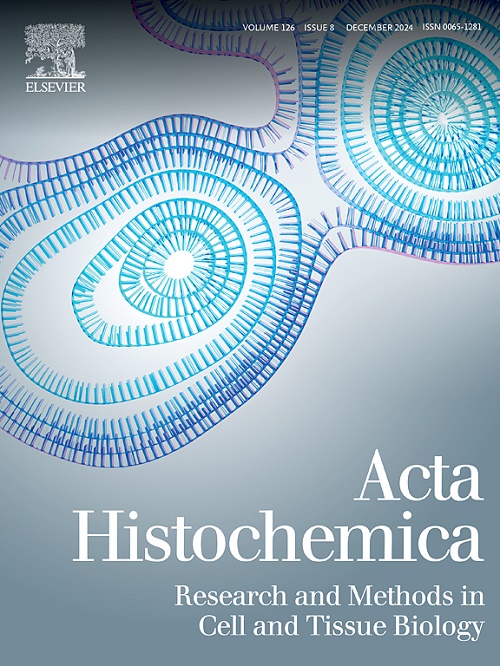尿素A通过下调vdac1介导的自噬在阿尔茨海默病中的神经保护作用
IF 2.4
4区 生物学
Q4 CELL BIOLOGY
引用次数: 0
摘要
阿尔茨海默病(AD)患者大脑中淀粉样蛋白β (Aβ)的积累有助于认知障碍和神经元损伤。尿素A (UA)是一种肠道微生物衍生的鞣花酸代谢物,据报道可以穿过血脑屏障,在大脑中发挥抗炎和抗氧化作用。然而,UA在AD中的分子机制尚不清楚。本研究旨在探讨UA对APP/PS1小鼠及a β1 - 42损伤的N2a和PC12细胞的神经保护作用及其机制。方法采用Morris水迷宫法检测大鼠认知功能。应用免疫荧光法检测APP/PS1小鼠脑内Aβ的沉积及电压依赖性阴离子通道1 (VDAC1)的表达。Western blotting检测VDAC1、AMPK通路、PI3K通路及自噬相关蛋白的表达。CCK8检测a β1 - 42损伤细胞的活力。结果本研究发现UA可改善APP/PS1小鼠的认知功能障碍,减少Aβ沉积。此外,UA在APP/PS1小鼠和a β1 - 42损伤的N2a和PC12细胞中激活自噬并上调自噬相关蛋白的水平。同时,UA下调APP/PS1小鼠及a β1 - 42损伤的N2a细胞和PC12细胞中PI3K/AKT/mTOR的磷酸化水平,上调AMPK的磷酸化水平。此外,UA下调VDAC1,与VDAC1拮抗剂DIDS(4′-二异硫氰酸-2,2′-二磺酸二苯乙烯)的作用一致。重要的是,uva诱导的自噬激活和PI3K和AMPK通路的调节被VDAC1过表达逆转。结论UA下调VDAC1通过抑制PI3K/AKT/mTOR通路,激活AMPK通路促进自噬,在AD中发挥关键的神经保护作用。本文章由计算机程序翻译,如有差异,请以英文原文为准。
Neuroprotective effect of Urolithin A via downregulating VDAC1-mediated autophagy in Alzheimer's disease
Background
Amyloid β (Aβ) accumulation in the brains of patients with Alzheimer's disease (AD) contributes to cognitive impairment and neuronal damage. Urolithin A (UA), a gut microbiota–derived metabolite of ellagic acid, has been reported to cross the blood-brain barrier to exert anti-inflammatory and anti-oxidation effects in the brain. However, the molecular mechanisms of UA in AD were still unclear. This study aims to explore the neuroprotective effect and mechanism of UA on APP/PS1 mice and Aβ1–42-injured N2a and PC12 cells.
Methods
In this study, Morris water maze was used to detect the cognitive function. Immunofluorescence was used to detect the deposition of Aβ and the expression of voltage-dependent anion channel 1 (VDAC1) in the brains of APP/PS1 mice. Western blotting was used to detect the expression of VDAC1, AMPK pathway, PI3K pathway and autophagy-related proteins. CCK8 was used to detect the viability of Aβ1–42-injured cells.
Results
In this research, we found that UA improved cognitive dysfunction and reduced Aβ deposition in APP/PS1 mice. Furthermore, UA activated autophagy and upregulated the levels of autophagy-related proteins in both APP/PS1 mice and Aβ1–42-injured N2a and PC12 cells. At the same time, UA down-regulated the phosphorylation level of PI3K/AKT/mTOR and up-regulated the phosphorylation level of AMPK in APP/PS1 mice and Aβ1–42-injured N2a cells and PC12 cells. In addition, UA down-regulated VDAC1, consistent with the effect of VDAC1 antagonist DIDS (4′-diisothiocyano-2,2′-disulfonic acid stilbene). Importantly, the UA-induced activation of autophagy and modulation of the PI3K and AMPK pathways were reversed by VDAC1 overexpression.
Conclusion
These findings demonstrated that UA down-regulated VDAC1 played a key neuroprotective role on AD by inhibiting the PI3K/AKT/mTOR pathway and activating the AMPK pathway to promote autophagy.
求助全文
通过发布文献求助,成功后即可免费获取论文全文。
去求助
来源期刊

Acta histochemica
生物-细胞生物学
CiteScore
4.60
自引率
4.00%
发文量
107
审稿时长
23 days
期刊介绍:
Acta histochemica, a journal of structural biochemistry of cells and tissues, publishes original research articles, short communications, reviews, letters to the editor, meeting reports and abstracts of meetings. The aim of the journal is to provide a forum for the cytochemical and histochemical research community in the life sciences, including cell biology, biotechnology, neurobiology, immunobiology, pathology, pharmacology, botany, zoology and environmental and toxicological research. The journal focuses on new developments in cytochemistry and histochemistry and their applications. Manuscripts reporting on studies of living cells and tissues are particularly welcome. Understanding the complexity of cells and tissues, i.e. their biocomplexity and biodiversity, is a major goal of the journal and reports on this topic are especially encouraged. Original research articles, short communications and reviews that report on new developments in cytochemistry and histochemistry are welcomed, especially when molecular biology is combined with the use of advanced microscopical techniques including image analysis and cytometry. Letters to the editor should comment or interpret previously published articles in the journal to trigger scientific discussions. Meeting reports are considered to be very important publications in the journal because they are excellent opportunities to present state-of-the-art overviews of fields in research where the developments are fast and hard to follow. Authors of meeting reports should consult the editors before writing a report. The editorial policy of the editors and the editorial board is rapid publication. Once a manuscript is received by one of the editors, an editorial decision about acceptance, revision or rejection will be taken within a month. It is the aim of the publishers to have a manuscript published within three months after the manuscript has been accepted
 求助内容:
求助内容: 应助结果提醒方式:
应助结果提醒方式:


